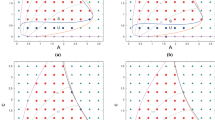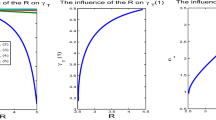Abstract
A fractional power of the Laplacian is introduced to a reaction–diffusion system to describe water’s anomalous diffusion in a semiarid vegetation model. Our linear stability analysis shows that the wavenumber of Turing pattern increases with the superdiffusive exponent. A weakly nonlinear analysis yields a system of amplitude equations, and the analysis of these amplitude equations shows that the spatial patterns are asymptotic stable due to the supercritical Turing bifurcation. Numerical simulations exhibit a bistable regime composed of hexagons and stripes, which confirm our analytical results. Moreover, the characteristic length of the emergent spatial pattern is consistent with the scale of vegetation patterns observed in field studies.





Similar content being viewed by others
References
Benson DA, Wheatcraft SW, Meerschaert MM (2000) The fractional-order governing equation of Lévy motion. Water Resour Res 36:1413–1423
Borgogno F, D’Odorico P, Laio F, Ridolfi L (2009) Mathematical models of vegetation pattern formation in ecohydrology. Rev Geophys 47:RG1005
Bouchard JP, Georges A (1990) Anomalous diffusion in disordered media: statistical mechanics, model and physical application. Phys Rep 195:127–293
Couteron P, Anthelme F, Clerc M, Escaff D, Fernandez-Oto C, Tlidi M (2014) Plant clonal morphologies and spatial patterns as self-organized responses to resource-limited environments. Phil Trans R Soc A 372:20140102
Escaff D, Fernandez-Oto C, Clerc MG, Tlidi M (2015) Localized vegetation patterns, fairy circles, and localized patches in arid landscapes. Phys Rev E 91:022924
Gafiychuk VV, By Datsko (2006) Pattern formation in a fractional reaction-diffusion system. Phys A 365:300–306
Gambino G, Lombardo MC, Sammartino M (2013) Turing pattern formation in the Brusselator system with nonlinear diffusion. Phys Rev E 88:042925
Golovin AA, Matkowsky BJ, Volpert VA (2008) Turing pattern formation in the Brusselator model with superdiffusion. SIAM J Appl Math 69:251–272
Henry BI, Langlands TAM, Wearne SL (2005) Turing pattern formation in fractional activator-inhibitor systems. Phys Rev E 72:026101
Huang W, Sloan DM (1994) A simple adaptive grid method in two dimensions. SIAM J Sci Comput 15:776–797
Kealy BJ, Wollkind DJ (2012) A nonlinear stability analysis of vegetative Turing pattern formation for an interaction-diffusion plant-surface water model system in an arid flat environment. Bull Math Biol 74:803–833
Klausmeier CA (1999) Regular and irregular patterns in semiarid vegetation. Science 284:1826–1828
Lefever R, Lejeune O (1997) On the origin of tiger bush. Bull Math Biol 59:263–294
Lejeune O, Tlidi M (1999) A model for the explanation of vegetation stripes (tiger bush). J Veg Sci 10:201–208
Lejeune O, Tlidi M, Lefever R (2004) Vegetation spots and stripes: dissipative structures in arid landscapes. Int J Quant Chem 98:261–271
Ludwig JA, Tongway DJ (1995) Spatial organisation of landscapes and its function in semi-arid woodlands, Australia. Land Ecol 10:51–63
Metzler R, Klafter J (2000) The random walk’s guide to anomalous diffusion: a fractional dynamics approach. Phys Rep 339:1–77
Metzler R, Klafter J (2004) The restaurant at the end of the random walk: recent developments in the description of anomalous transport by fractional dynamics. J Phys A 37:R161
Montana C, Lopez-Portillo J, Mauchamp A (1990) The response of two woody species to the conditions created by a shifting ecotone in an arid ecosystem. J Ecol 78:789–798
Nec Y, Nepomnyashchy AA, Golovin AA (2008) Oscillatory instability in super-diffusive reaction-diffusion systems: fractional amplitude and phase diffusion equations. Europhys Lett 82:58003
Okubo A, Levin S (2002) Diffusion and ecological problems: modern perspectives. Springer, New York
Ridif L, D’Odorici P, Laio F (2011) Noise induced phenomena in the environmental sciences. Cambridge University Press, Cambridge
Sherratt JA (2005) An analysis of vegetative stripe formation in semi-arid landscape. J Math Biol 51:183–197
Sokolov IM, Klafter J, Blumen A (2002) Fractional kinetics. Phys Today 55:48–54
Tlidi M, Lefever R, Vladimirov A (2008) On vegetation clustering, localized bare soil spots and fairy circles. Lect Notes Phys 751:381–402
Weiss M, Hashimoto H, Nilsson T (2003) Anomalous protein diffusion in living cells as seen by fluorescence correlation spectroscopy. Biophys J 84:4043–4052
White LP (1970) Brousse tigree patterns in southern Niger. J Ecol 58:549–553
Worrall GA (1960) Tree patterns in the Sudan. J Soil Sci 11:63–67
Zhang L, Tian C (2014) Turing pattern dynamics in an activator-inhibitor system with superdiffusion. Phys Rev E 90:062915
Acknowledgments
C. T. acknowledges the support from the National Natural Science Foundation of China (Grant No. 11201406), and the Qinglan Project.
Author information
Authors and Affiliations
Corresponding author
Appendix: Derivation of the Amplitude Equation
Appendix: Derivation of the Amplitude Equation
In this appendix, we sketch a derivation of the amplitude Eq. (18). Note that in Zhang and Tian (2014), the authors study a fractional system with the same fractional order. However, in the system (4), the two fractional orders are different.
Since \(\mathbf {L_c}\) is the linear operator of the system at the Turing instability threshold, \((u_1,v_1)^T\) is the eigenvector corresponding to the eigenvalue 0. Therefore, at \(O(\varepsilon )\) the solution is given in the form
where A(T) is the amplitude of the pattern and is still arbitrary at this level. Its form is determined by the perturbational term of the higher order. The vector \(\mathbf {\rho }\) is defined up to a constant, and we shall make the normalization in the following way:
Next, we turn to \(O(\varepsilon ^2)\). The equation is written in the form
Since the right-hand side does not have the resonance, the Fredholm alternative is automatically satisfied. The solution of system (23) is then explicitly computed in terms of the parameters of the full system
where \(\mathbf {w_{20}}\) and \(\mathbf {w_{22}}\) are, respectively, the solutions of the following linear systems
Now \(O(\varepsilon ^3)\). The equation is written in the form
According to the Fredholm solubility condition, the vector function of the right-hand side must be orthogonal with the zero eigenvalues of the operator \(\mathbf {L_c^+}\) to ensure the existence of the nontrivial solution to this equation, where \(\mathbf {L_c^+}\) is the adjoint operator of \(\mathbf {L_c}\). The nontrivial kernel of the operator \(\mathbf {L_c^+}\) is
In order to ensure the Fredholm solubility condition, we only consider the resonance of the system (26). Thus, we have the amplitude equation
where
Rights and permissions
About this article
Cite this article
Tian, C. Turing Pattern Formation in a Semiarid Vegetation Model with Fractional-in-Space Diffusion. Bull Math Biol 77, 2072–2085 (2015). https://doi.org/10.1007/s11538-015-0116-2
Received:
Accepted:
Published:
Issue Date:
DOI: https://doi.org/10.1007/s11538-015-0116-2




